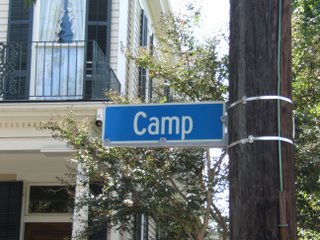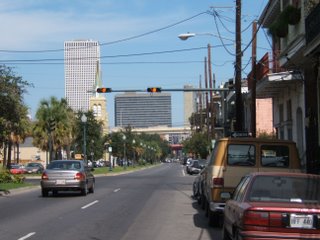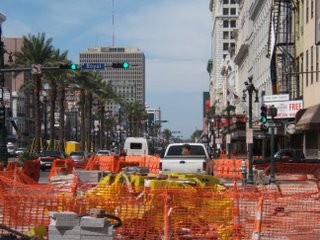A Path Through New Orleans

It wasn’t until very recently that I rediscovered the experience of riding a bike. In the process of moving to New Orleans, I decided that I could save a good deal of money on gas (and tires, thanks to all the nails and potholes) if I didn't bring my car, and instead used a bike to get around. Not having ridden a bike for some time, this became quite a life-style change as I had depended on my car to get around for the entirety of my post-adolescent life. In college, I had always lived close enough to school to walk, and if I couldn’t walk it, I drove it. Now, living in a new city, having to travel farther than ever before to get to school, I was without my Oldsmobile!
My house is located in Uptown, a neighborhood about seven miles from our studio, which is located in Bywater. At first the distance was somewhat intimidating. Previously, I had never had to travel more than half a mile to get to my classes. The thought of embarking on a seven-mile journey through one of the most dangerous cities in America twice daily made me at times, question my choice not to bring a car. But my fears were soon curbed, as I realized that biking it in new Orleans is the only way to go. The roads here are totally flat, and almost all one-way. It is also much easier to avoid annoying traffic laws such as stop-signs. Riding my bike to school allows me to experience the city in a way that could never be achieved in an automobile.
My daily journey begins on Magazine Street. where I live. Now, Magazine is not the ideal bike route to take. It is extremely busy, and extremely narrow, which is a bad combination.
 Instead, I cut up one block and take Camp Street, which is wide, and predominantly residential. Because it follows the river, Camp Street is continuous and runs the full length of the distance I have to travel. What is so great about this particular route is that in its entirety, it runs through some of the most beautiful, historically famous areas in New Orleans, and probably in all of North America.
Instead, I cut up one block and take Camp Street, which is wide, and predominantly residential. Because it follows the river, Camp Street is continuous and runs the full length of the distance I have to travel. What is so great about this particular route is that in its entirety, it runs through some of the most beautiful, historically famous areas in New Orleans, and probably in all of North America.
The route begins in the college are of Uptown, which is close to Tulane and Loyola. The houses here are modest, but beautiful. Mostly shotgun style, they rarely reach more than two stories, creating a consistently low urban streetscape throughout. The live oaks along the street tower over the avenue and the houses, creating a tunnel like condition, that provides shade for the long ride.

Crossing Louisiana Avenue, the houses begin to grow considerably, as do the spaces between them. This is the garden district. In this area of the city, one starts to sense a real change in scale.
 Houses are at least two stories, and each is surrounded by plenty of green-space. The vegetation, however, is what is so defining about this area. Every house is surrounded by huge live oaks, banana plants, flowers, and shrubbery, and is unlike any neighborhood I have ever been in.
Houses are at least two stories, and each is surrounded by plenty of green-space. The vegetation, however, is what is so defining about this area. Every house is surrounded by huge live oaks, banana plants, flowers, and shrubbery, and is unlike any neighborhood I have ever been in.
The beautiful, gigantic, grand houses of the area take a backseat to the gardens that surround each of them. In places it feels like a tropical forest, and I forget that I am am in a city at all. The smell of the flowers becomes overwhelming at times, and you have to remind yourself to watch the road and not the scenery.

Soon, Camp merges with the inbound traffic of Magazine street, and I once again have to start really minding my surroundings. The speed limit goes from twenty-five to forty-five, and the street widens into two-lanes each way. This is I get my first view of downtown New Orleans.

Approaching the Central Business District, the buildings begin to increase massively in scale, and the experience changes totally. I am now an ant in a deep crevasse, desperately trying to keep up with the larger, faster moving traffic.
Finally, after about twenty minutes of riding, I arrive at a large intersection, which dramatically cuts short the overwhelming scale of the surroundings: this is where Canal Street, which is, in fact, an urban canal cutting through the city, separates the CBD from the French Quarter.
 Crossing this road is like a time-warp, because if it weren't for the cars, you wouldn't be able to tell what century you were in. On one side is the fast-paced, American-urban experience of the 21st century; On the other side, one travels back in time, to an entirely different era or country.
Crossing this road is like a time-warp, because if it weren't for the cars, you wouldn't be able to tell what century you were in. On one side is the fast-paced, American-urban experience of the 21st century; On the other side, one travels back in time, to an entirely different era or country.  Camp Street now becomes Chartres Street, and where the buildings stand at all the same height, and create a long shaded cavern of widened lanes and side-walks. The sights and smells along this part of the route are unbelievable. The minute I enter the French Quarter, my senses become totally overwhelmed, as I pass tourists, bums, strippers, chefs, business men, and cops all on the same path.
Camp Street now becomes Chartres Street, and where the buildings stand at all the same height, and create a long shaded cavern of widened lanes and side-walks. The sights and smells along this part of the route are unbelievable. The minute I enter the French Quarter, my senses become totally overwhelmed, as I pass tourists, bums, strippers, chefs, business men, and cops all on the same path.  An aroma of garbage, stale beer, and the most wonderful food one could possibly dream of eating all enter my nose at the same time. As for biking, the traffic is still pretty dense, and I really have to watch out for the opening car doors.
An aroma of garbage, stale beer, and the most wonderful food one could possibly dream of eating all enter my nose at the same time. As for biking, the traffic is still pretty dense, and I really have to watch out for the opening car doors. 
After a few blocks, the road stops abruptly at Jackson Square, and I am forced to leave the street and weave through the tourists, the fortune tellers, the pigeons, and the homeless. Upon leaving Jackson Square, the French quarter becomes quiet.
 There is no longer any traffic, and I truly begin to feel the age of everything around me. At times I even wonder if the person I'm passing on the street is really there, or just a ghost of New Orlean's past. I pass by streets like Frenchman, that on any given night are full of life, and the best music in all of the city, but in the morning, one might not even notice.
There is no longer any traffic, and I truly begin to feel the age of everything around me. At times I even wonder if the person I'm passing on the street is really there, or just a ghost of New Orlean's past. I pass by streets like Frenchman, that on any given night are full of life, and the best music in all of the city, but in the morning, one might not even notice. 
Leaving the French Quarter, I enter the Fauburg Marigny, originally a French residential neighborhood. The houses here are once again all shotgun style, one-story, but they are much closer together than the houses of Uptown or the Garden district, creating a denser urban fabric. At this point I start to notice that the traffic is no longer dominated by automobiles, but instead by bicycles. The Marigny is home to artists, musicians, transvestites, and "freaks and weirdos" from all different walks of life.
 They travel around on their bicycles, coexisting without the slightest effort in a part of New Orleans which for me, has become one of the most intriguing. This is the point on the city grid that bends or breaks from the rest, disrupting the linear axis of the preceding streets. It does this physically and metaphorically, mirroring the paths of the people who occupy it. New Orleans has always been a home to rougues, outlaws, and people who refused to go along with the confines of the social fabric of American culture. Many still find refuge at this breaking point.
They travel around on their bicycles, coexisting without the slightest effort in a part of New Orleans which for me, has become one of the most intriguing. This is the point on the city grid that bends or breaks from the rest, disrupting the linear axis of the preceding streets. It does this physically and metaphorically, mirroring the paths of the people who occupy it. New Orleans has always been a home to rougues, outlaws, and people who refused to go along with the confines of the social fabric of American culture. Many still find refuge at this breaking point.The final stretch of the journey takes me into the Bywater. The dense houses disappear and are replaced by large warehouses.
 Along my path to the right is a large wall that separates the neighborhood from the mighty Mississippi where one can see the tops of large cargo ships creeping along the edge. The effect of the hurricane starts to reveal itself more than ever as I start to notice the debris on the road, and the coded FEMA spraypaint that marks each building, jolting me back to the reality of why I am here.
Along my path to the right is a large wall that separates the neighborhood from the mighty Mississippi where one can see the tops of large cargo ships creeping along the edge. The effect of the hurricane starts to reveal itself more than ever as I start to notice the debris on the road, and the coded FEMA spraypaint that marks each building, jolting me back to the reality of why I am here. While the route I take to studio everyday is beautiful, scenic, uplifting, and amazing in everyway, it is in no way representative of the state of New Orleans. The small stretch of land is not unlike a preserved artifact that tells a story of what used to be, not what is. It is easy to lose yourself in the beauty and grandeur of everything that these places offer, but the red sign spray-painted on the wall of our studio tells the story of the rest of New Orleans:
 a New Orleans that has yet to recover from the most devastating natural disaster in American history.
a New Orleans that has yet to recover from the most devastating natural disaster in American history.

0 Comments:
Post a Comment
<< Home